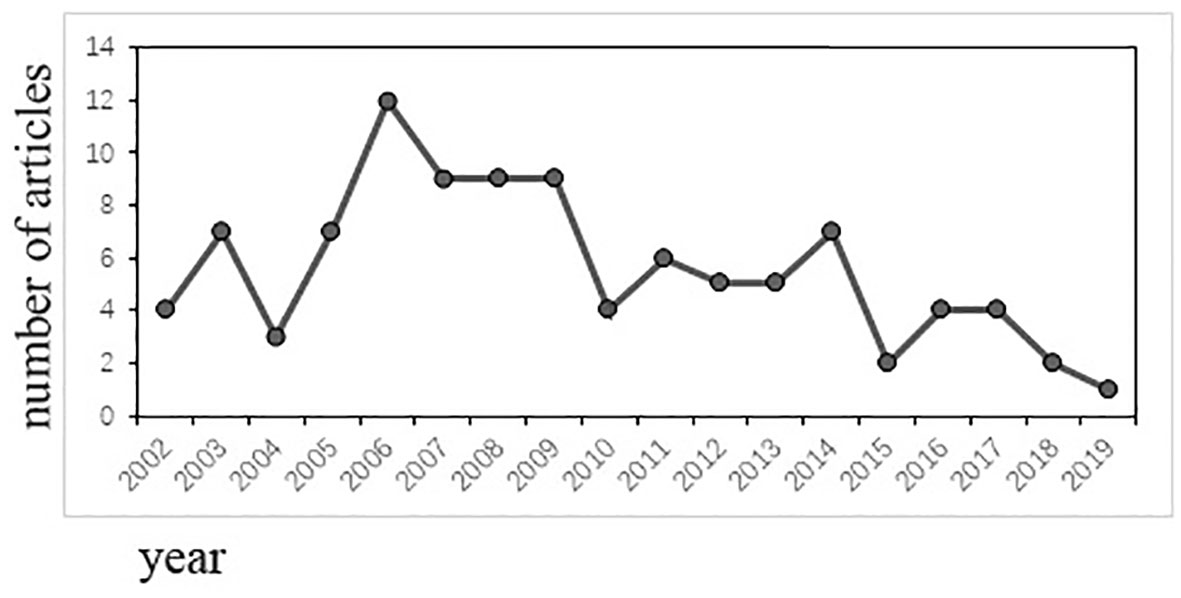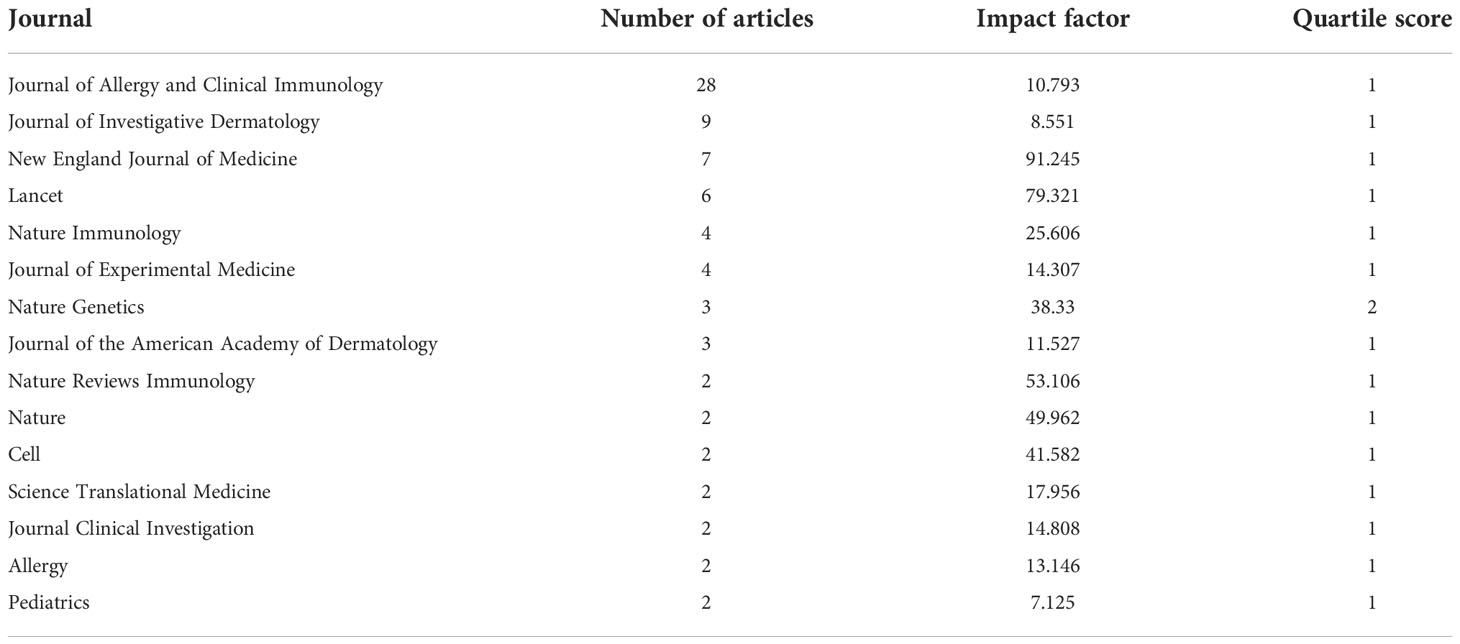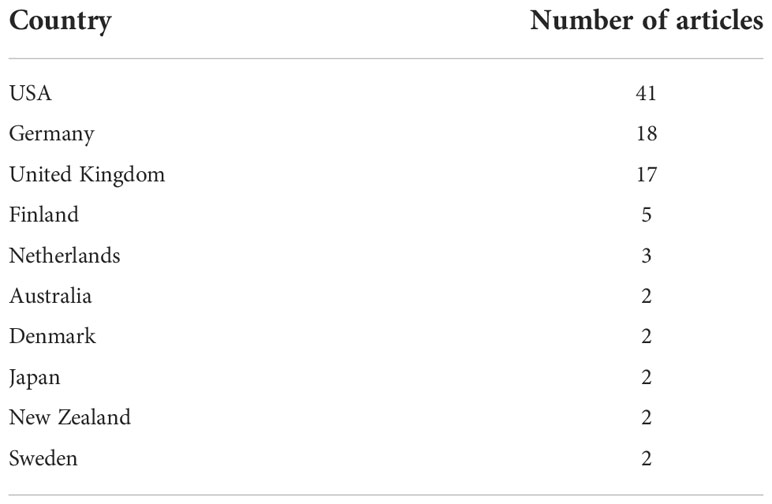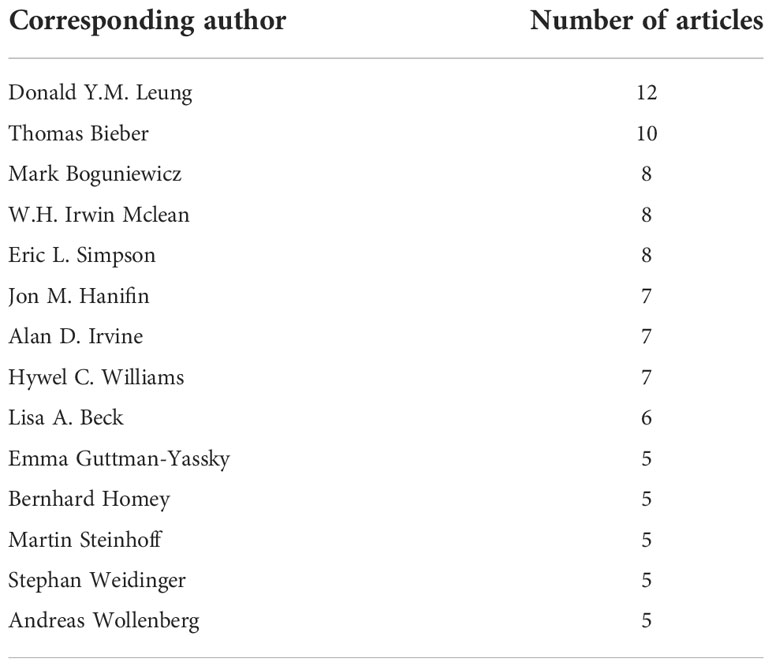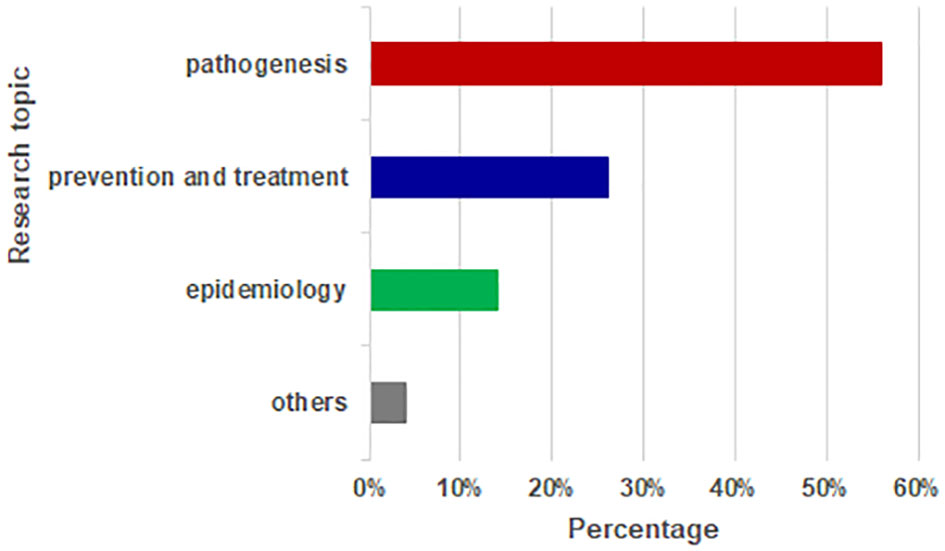- 1Department of Allergy, State Key Laboratory of Complex Severe and Rare Diseases, Peking Union Medical College Hospital, Chinese Academy of Medical Sciences and Peking Union Medical College, Beijing, China
- 2Allergy Department, Beijing Key Laboratory of Precision Medicine for Diagnosis and Treatment of Allergic Diseases, National Clinical Research Center for Dermatologic and Immunologic Diseases, Peking Union Medical College Hospital, Chinese Academy of Medical Sciences and Peking Union Medical College, Beijing, China
- 3Department of Dermatology, State Key Laboratory of Complex Severe and Rare Diseases, Peking Union Medical College Hospital, Chinese Academy of Medical Sciences and Peking Union Medical College, National Clinical Research Center for Dermatologic and Immunologic Diseases, Beijing, China
Background: Atopic dermatitis (AD) is the leading cause of skin-related disease burden worldwide, affecting a large percentage of the population. Bibliometrics is the statistical analysis of academic literature in a certain field.
Objectives: We aimed to perform the latest bibliometric analysis of atopic dermatitis literature.
Methods: We searched the Web of Science database on 29th Nov 2021. We used the keywords “atopic dermatitis,” “atopic eczema,” and “eczema” for our search. All items published between 2001 and 2021 were included. The top 100 most cited articles were identified and analyzed.
Results: Our study provided a detailed bibliometric analysis of the top 100 most cited articles on atopic dermatitis. These articles were published between 2002 and 2019 and were from 15 different countries, mostly in the USA and Germany. Most articles have focused on the pathogenesis and treatment of AD. The Journal of Allergy and Clinical Immunology made the greatest contribution to the top 100 list, with 28 articles. The most cited article originated from Lancet. The highest number of citations was seen in 2006, with 9220 citations, while the highest number of publications was seen in 2006 with 12 publications.
Conclusions: Our study aims to provide physicians and researchers with a historical perspective for the scientific progress of atopic dermatitis, and help clinicians effectively obtain useful articles that have a significant impact on the field of atopic dermatitis.
Introduction
Atopic dermatitis (AD) is a chronic relapsing inflammatory skin disease, which is characterized by severe itching, dryness, and erythematous rashes (1). AD may seriously affect the quality of life of patients and their families due to intense pruritus, sleeping loss, psychosocial impact, and substantial economic burden caused by costs of medical treatment (2, 3). The prevalence of AD is approximately 20% among children and it ranges between 7% and 14% among adults (4).
The bibliometric study represents an important study type showing the main research focuses or hotspots and trend topics in a given field (5). It could provide a systematic description and visual representation of the structure of a particular field for physicians and researchers. So far, many dermatologists have published the most cited articles in the form of bibliometric analysis on topics such as hidradenitis suppurativa, rosacea, and psoriasis (6–8).
The purpose of our study was to analyze the top 100 most cited AD articles published in the biomedical literature during the last 20 years and pave the way for further investigations for AD.
Methods
Search strategy
We have compared the pros and cons for each of them based on AlRyalat et al’s study and we finally chose the Web of Science (WOS) core collection for our bibliometric analysis (9). An important reason for this choice is the availability of a precise and comprehensive description of highly cited papers and hot papers. This feature is not available in other databases. We searched the WOS core database (accessed: 2021-11-29) using the topic “eczema”, “atopic dermatitis”, and “atopic eczema” between 2002 and 2021. There were no limitations on document types or languages. The results were sorted in descending order according to the number of citations cited in the WOS. Two researchers (Lishan Zhang and Yibo Hou) independently screened the abstract to obtain qualified articles. Studies on AD or studies including AD as the main part were included in our analysis scope. Articles not relevant to AD were excluded from our analysis. Under the guidance of senior experts (Yueping Zeng and Jinlyu Sun), two researchers finally reached an agreement on the top 100 most cited articles (T100) list.
Data extraction and conversion
Data including titles, authors, countries, institutes, year of publication, journals of publication, article types, impact factors, and total citations were collected from the WOS core database to excel. The Countries and institutes were recorded based on the information of the first corresponding author. The types of articles were categorized by original research, review article, clinical trial, clinical study, and comment. Journal impact factors were derived from 2020 Journal Citation Reports. As we all know, a citation is an important metric that shows the quality and influence of an article. However, a certain amount of time should be allowed to pass after the publication of an article for it to reach a higher number of citations. In our study, the average citations per year (ACY) score was used to eliminate the time bias, which provides a fairer comparison for junior academics. ACY = citation times/(2021-publication year+1).
Bibliometric analysis
Bibliometrix R-package software, an open-source software, was used for conducting quantitative analysis in our study. R-package was developed by Aria and Cuccurullo and written in R language, which can help users without coding skills to perform bibliometric analysis (10). After installing R on our computer, data downloaded from WOS in Plain Text format was uploaded to the Biblioshiny app. The Biblioshiny interface provides us with a set of tools for conducting statistics. Besides, we classified the selected articles into four categories based on the research topic, including pathogenesis, prevention and treatment, epidemiology, and others. “Pathogenesis” includes studies on exploring the origination and development of AD; “prevention and treatment” includes studies on the prevention and treatment of AD; “epidemiology” is the study of diseases in populations, investigating how, when, and why they occur; “others” includes the studies that do not belong to the above categories.
Ethical statement
This research was designed as a bibliometric analysis of published studies and did not involve any animal experiments or unreported clinical trials of human beings. Thus, approval from an ethics committee was not required.
Results
A total of 37,937 documents were retrieved from the WOS Core Collection databases between 2002 and 2021. The top 100 most cited articles were listed in Table 1 and sorted in descending order according to the number of citations. For the study types of the T100 articles on AD, reviews accounted for 37%, followed by basic science researches 27%, clinical trials 21%, clinical studies 10%, comments 1%, and others 4%.
Year of publication
The top 100 most cited articles were published between 2002 and 2019. Figure 1 showed the number of articles published during these 18 years. There was a peak in the region of 2006-2009. The largest number of articles published was 12, which occurred in 2006.
Citations
The number of citations ranged from 310 to 2814. We found that the most cited article on AD was a study conducted by Asher et al. with the following title, “Worldwide time trends in the prevalence of symptoms of asthma allergic rhinoconjunctivitis, and eczema in childhood: ISAAC Phases One and Three repeat multicountry cross-sectional surveys,” which was published in Lancet, and this article also had the second highest ACY score. The least cited article was “Loricrin and involucrin expression is down-regulated by Th2 cytokines through STAT-6”, which was published in Clinical Immunology. The annual total citations and average article citations per year are shown in Figure 2. The total number of citations was the highest in 2006, reaching 9220, and the most cited article also appeared in 2006. The average number of annual citations was constantly increasing. Additionally, we found that eight articles received more than 1000 citations, and half of them were published in Lancet and The New England Journal of Medicine.
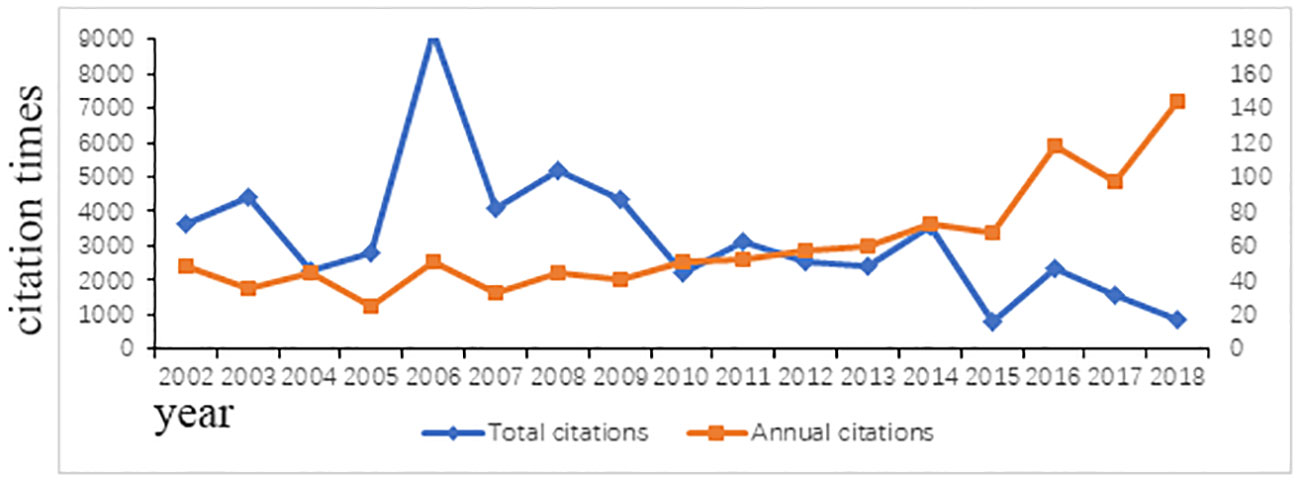
Figure 2 The annual total citations and average annual citations. The orange line represents the average annual citations of the published articles in different year, and the blue line represent the average total citations.
Journal of publication
The 100 articles were published across 37 different journals. The Journal of Allergy and Clinical Immunology published the most (n=28), followed by The Journal of Investigative Dermatology (n=9), The New England Journal of Medicine (n=7), and Lancet (n=6). The top 10 journals were listed in Table 2 with their impact factors and quartile scores. There were 91 articles published in journals in which the “Quartile Score” category was Q1. Of the T100 articles, 74 were published in 24 journals that had an IF>10.
Countries and authors
The first corresponding authors of the 100 articles were from 15 different countries. According to the list, the USA (n=41) was the most contributing country, followed by Germany (n=18) and the United Kingdom (n=17) (Table 3). The highest-ranking 10 authors in the T100 cited articles were listed in Table 4. We found that Prof. Donald Leung, from the University of Colorado, produced the most top-cited articles on AD (n=12), followed by Prof. Thomas Bieber (n=10).
Keywords analysis, co-occurrence network, and trend topics
Analysis of authors’ most used keywords is an important tool for exploring hot topics in this field and scholars’ focus. The word cloud in Figure 3 showed the frequently used keywords were asthma, filaggrin, and skin barrier besides eczema. In addition, we investigated the keywords’ co-occurrence network to reveal the connections between keywords in works of literature (Figure 4). Notably, filaggrin played an important role in the co-occurrence network. Trend topics analysis gave further insight into the trending topics in terms of keyword occurrences in AD literature over the years (Figure 5). While conducting the analysis, the following parameters were configured. The search field was set to abstract. Word minimum frequency was set to 40 and the number of words per year was set to 2. Cytokines and skin barriers were the most discussed topic between 2006 and 2013. The result also showed that dupilumab (the first biologic agent approved for patients with moderate to severe AD) became a trending topic since 2015.
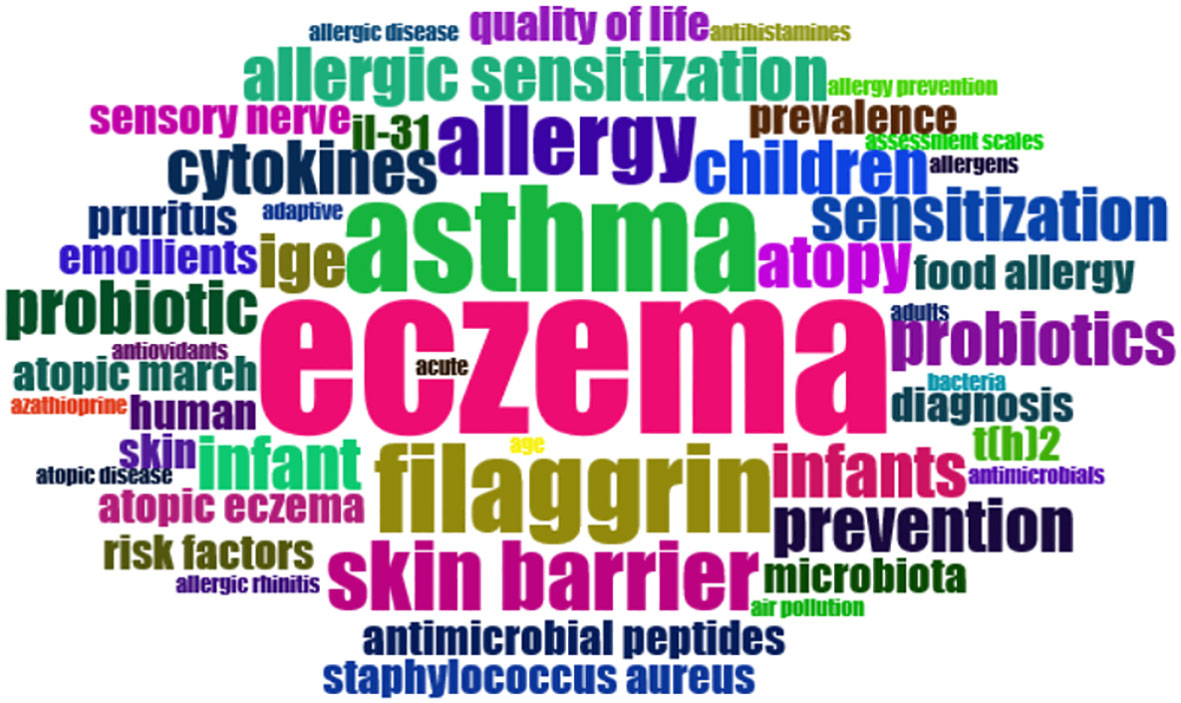
Figure 3 A visualized word cloud of frequently used keywords in the T100 list. The font size represents the number of repetitive keywords.
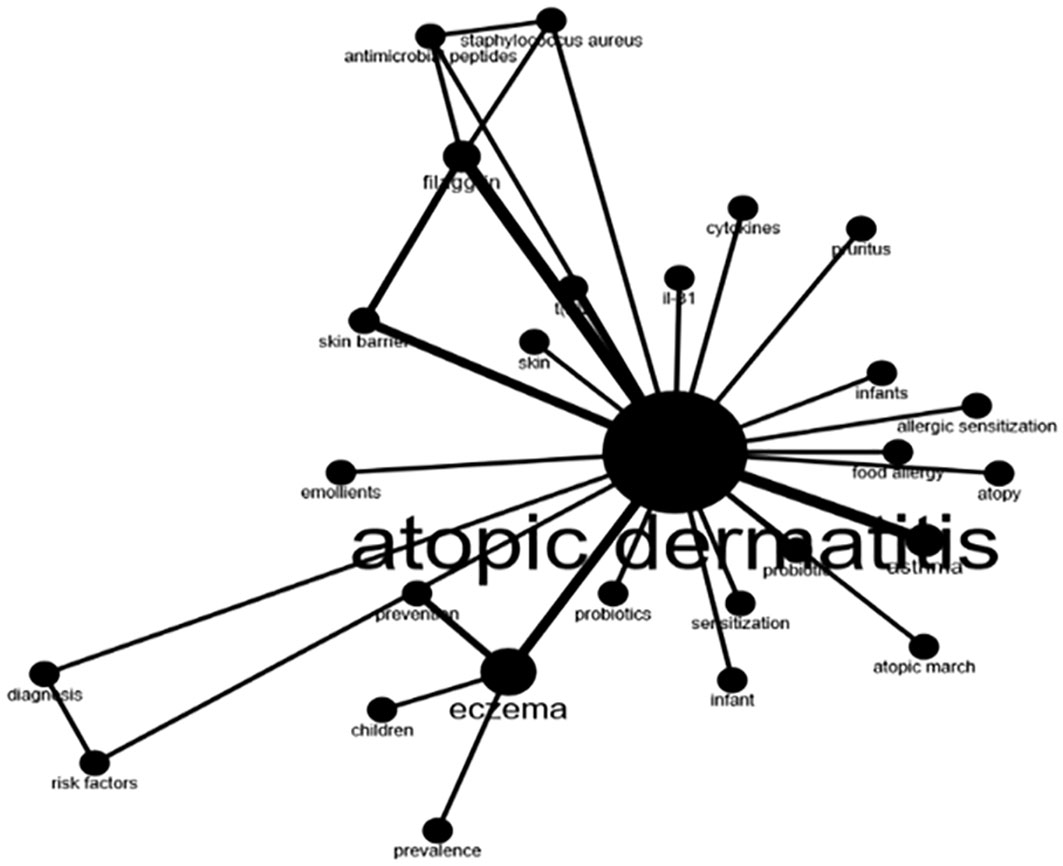
Figure 4 A co-occurrence networks. Thick lines indicate a strong relationship between those keywords. Thin lines represent weak association. Keywords without connecting lines indicate that no relationship has been established.
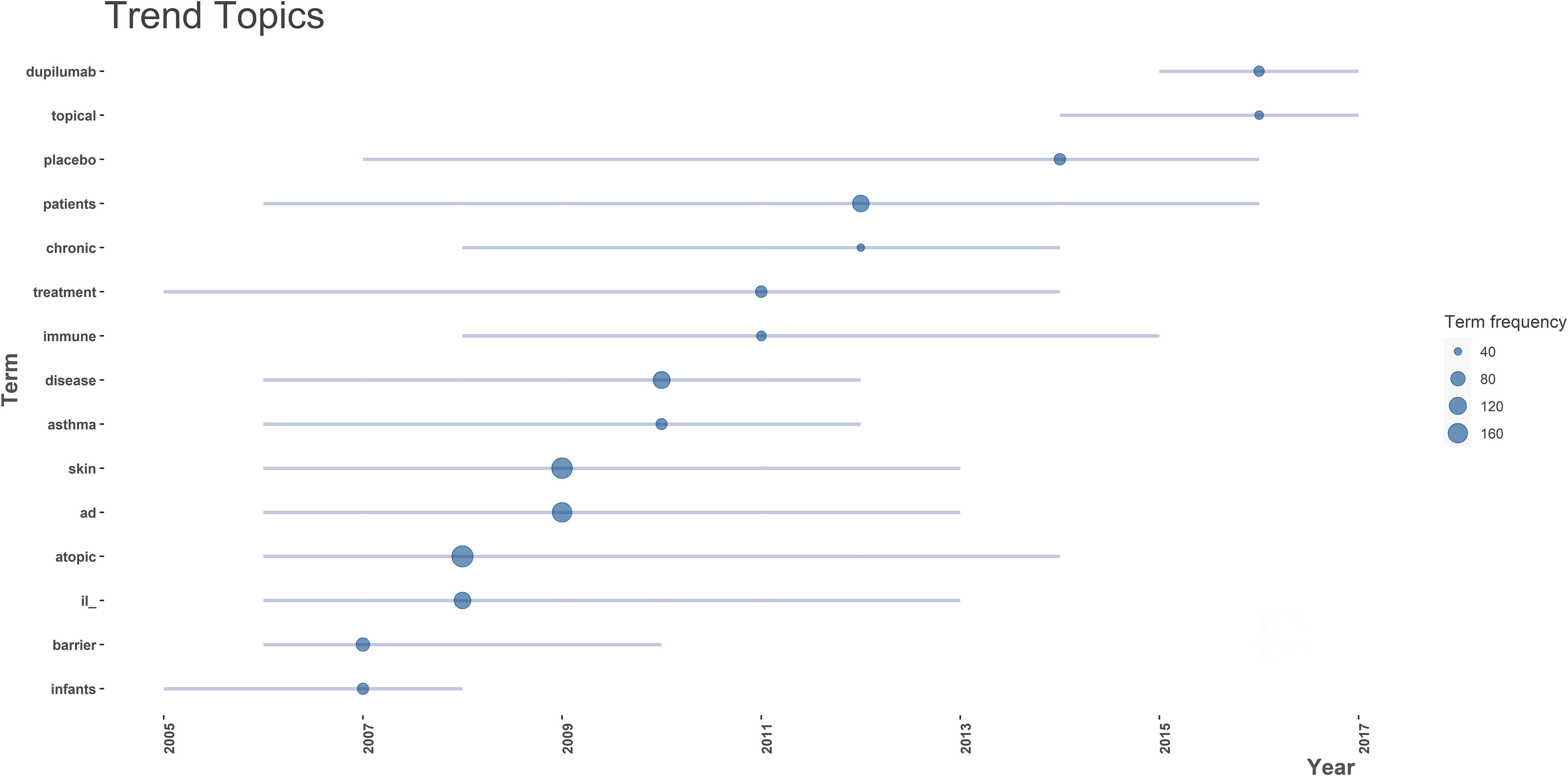
Figure 5 The trend topics analysis presents the hierarchical arrangement of topics in atopic dermatitis (AD) discussed by scholars per year. il, interleukin.
Discussion
AD is the most common chronic inflammatory skin disease in many developed countries (11). Recent trends have indicated that the prevalence of AD has increased in industrialized countries in recent decades and poses a significant burden on population health and healthcare settings (12). As we all know, citation analysis can provide comprehensive information about journals, institutions, and authors, which is available for identifying landmark papers and high-impact journals. Although it may not be possible to present a detailed analysis of all 100 top-cited articles, some features could be found. The bibliometric analysis can not only provide a deep insight into the most popular topics of AD in the past but also reveal the trend of AD research (13).
We found that in our T100, 36% of the articles were published less than 10 years prior, while 64% of them were more than 10 years before. However, the total ACY from 2002 to 2010 (ACY=2618) was lower than those from 2011 to 2019 (ACY=3065). It demonstrated that researchers paid more attention to AD in recent years. Although the 100 top-cited articles appeared in a total of 37 different journals, The Journal of Allergy and Clinical Immunology, Lancet, Cell, Nature, and The New England Journal of Medicine, were the main sources for nearly half of the articles (n=45). We found that core papers related to AD were published in a few top journals and these papers basically covered the overall situations of this field. This finding is consistent with Bradford’s law (14), which estimates the exponentially diminishing returns of extending a search for references in science journals and is commonly applied to determine the core journals in a specific field. Therefore, reading a few top journals could help busy dermatologists to keep updated in this field.
In addition, we noticed that all the articles with a marked influence came from developed countries. However, the latest available data from ISAAC (The International Study of Asthma and Allergies in Childhood), the largest worldwide collaborative research project, showed that AD continued to increase in prevalence specifically in developing countries, such as Latin America or South East Asia (15). Developing countries’ authors have limited involvement mainly due to the imbalance of global health resources between developed countries and developing countries (16).
The Biblioshiny app screens the themes of the literature according to the frequency of keywords in the selected literature. Sometimes it may not be able to reflect the main content of the article well. Therefore, we summarized the topic of the article manually. Articles were classified into one of the following four domains: pathogenesis, prevention and treatment, epidemiology, and others (Figure 6 and Table 1). Studies related to pathogenesis occupied the most articles (n=56). Extensive research has shed light on the multifaceted pathogenesis of the disease. Although an increasing number of studies have focused on AD, the etiology and pathogenesis of AD remain unclear. The bibliometric analysis shows that AD results from interactions among susceptibility, the environment, food allergy, skin barrier defects, gut microbial alterations, and immune disorders. Of these pathogenesis factors, the most critical one is skin barrier function. The most cited pathogenesis-related article was published in 2006, titled “Common loss-of-function variants of the epidermal barrier protein filaggrin are a major predisposing factor for atopic dermatitis”. This work demonstrated that impaired skin barrier function played a key role in the development of atopic disease. In addition, 15 articles proved that immune cells (Th2 and Th17 cells) and related cytokines (IL-31, IL-25, IL-33, and TSLP) involved in the inflammatory response played an indispensable role in AD. These findings have reflected the direction of research in the last 20 years, and will form an important basis for future research for developing new therapeutic modalities.
Recent developments in the understanding of AD pathogenesis have provided multiple options for treatments. In addition to the conventional therapies (application of moisturizers, topic corticosteroids, and immunosuppressants), targeted drugs including biologics and Janus kinase (JAK) inhibitors have been introduced as new options for AD. Of the T100 list, 26% were related to AD therapy. Sorting the literature in descending order of publication year, we observed that clinical trials on the safety and effectiveness of dupilumab were at the top ten list. The most cited article about dupilumab was a clinical trial published in the New England Journal of Medicine, titled “Two Phase 3 Trials of Dupilumab versus Placebo in Atopic Dermatitis”. It is only a 5-year-old article; however, it has 818 citations with an ACY score of 163.6 (rank: fifth). Dupilumab was the first biologic approved for moderate-to-severe AD and has become one of the most promising treatments for AD. Until the emergence of dupilumab, corticosteroids and immunosuppressant agents were the first-line therapies for rapid control of moderate-to-severe AD. Compared with conventional immunosuppressive therapy, dupilumab has good safety and can be used for the long-term treatment of AD (17). However, high cost may be a major consideration for dupilumab. To date, dupilumab has been approved for the remedy of type 2 immune diseases, such as asthma, and chronic rhinosinusitis with nasal polyps. Dupilumab will be used to relieve unmet clinical needs in other type 2 inflammation-related diseases (18). Furthermore, numerous biologics are now under investigation, including anti-IL-31RA monoclonal antibodies (nemolizumab) and anti-IL-13 monoclonal antibodies (tralokinumab and lebrikizumab). Besides, JAK inhibitors represent an emerging treatment option for AD. Abrocitinib, upadacitinib, and baricitinib are three oral JAK inhibitors approved for treating patients with AD, along with topical drugs ruxolitinib and delgocitinib. However, additional real-world studies are necessary to provide valuable data on the response and tolerability of these JAK inhibitors. The Global Burden of Disease has reported that skin diseases continue to be the fourth largest cause of nonfatal disease burden and AD accounts for the highest disease burden among skin diseases (19). Among the T100 list, there were fourteen articles related to the epidemiology of AD. One was a large multicenter cross-sectional survey conducted by Asher et al. and published in the Lancet, which has the highest citation number in the T100 list. Measuring the frequency of AD in a population and identifying how the disease frequency may differ over time or among subgroups are important steps in discovering potential causes and determining effective methods for prevention and care.
When we looked at the T100 list, another point of interest also caught our attention: the relationship between AD and intestinal microflora or skin microflora. Evidence suggested that skin and gut microbes might affect the course of AD. Six articles introduced research in this area. The most cited one was published in Genome Research, titled “Temporal shifts in the skin microbiome associated with disease flares and treatment in children with atopic dermatitis”. Studies indicated that an imbalance of the intestinal flora might be a factor leading to the deterioration of AD. Scientists have also proposed that the application of probiotics can regulate intestinal health by affecting the quantity and abundance of the intestinal microflora and modulating AD progression. Although several articles have described the efficacy of probiotics in AD, the exact curative effect remains uncertain.
In conclusion, this study identified the top 100 most cited articles on AD and analyzed their bibliometric characteristics, which may facilitate further research. However, there are still some shortcomings and limitations in our study. Firstly, the number of citations used did not exclude self-citations. Secondly, we only used the WOS database to conduct our research. Therefore, the list would be different if other databases were used.
Data availability statement
The raw data supporting the conclusions of this article will be made available by the authors, without undue reservation.
Author contributions
YZ, JS contributed to conception and design of the study. LZ, YH performed the statistical analysis and wrote the first draft of the manuscript. All authors contributed to manuscript revision, read, and approved the submitted version.
Funding
This study was supported by the National High Level Hospital Clinical Research Funding (2022-PUMCH-B-092; Dr. YZ); the National Natural Science Foundation of China (81602765; Dr. YZ), (81971515; Dr. JS).
Conflict of interest
The authors declare that the research was conducted in the absence of any commercial or financial relationships that could be construed as a potential conflict of interest.
Publisher’s note
All claims expressed in this article are solely those of the authors and do not necessarily represent those of their affiliated organizations, or those of the publisher, the editors and the reviewers. Any product that may be evaluated in this article, or claim that may be made by its manufacturer, is not guaranteed or endorsed by the publisher.
References
1. Bantz SK, Zhu Z, Zheng T. The atopic march: Progression from atopic dermatitis to allergic rhinitis and asthma. J Clin Cell Immunol (2014) 5(2):202. doi: 10.4172/2155-9899.1000202
2. Ariëns LFM, van Nimwegen KJM, Shams M, de Bruin DT, van der Schaft J, van Os-Medendorp H, et al. Economic burden of adult patients with moderate to severe atopic dermatitis indicated for systemic treatment. Acta Derm Venereol. (2019) 99(9):762–8. doi: 10.2340/00015555-3212
3. Na CH, Chung J, Simpson EL. Quality of life and disease impact of atopic dermatitis and psoriasis on children and their families. Children (Basel) (2019) 6(12):133. doi: 10.3390/children6120133
4. Bylund S, Kobyletzki LB, Svalstedt M, Svensson A. Prevalence and incidence of atopic dermatitis: A systematic review. Acta Derm Venereol (2020) 100(12):adv00160. doi: 10.2340/00015555-3510
5. Ellegaard O, Wallin JA. The bibliometric analysis of scholarly production: How great is the impact? Scientometrics (2015) 105(3):1809–31. doi: 10.1007/s11192-015-1645-z
6. Seivright J, Thompson A, Villa N, Shi V, Hsiao J. Bibliometric analysis of the 50 most cited publications in hidradenitis suppurativa. Skin Appendage Disord (2021) 85(3):B182. doi: 10.1159/000513771
7. Daou L, Hage SE, Wakim E, Safi S, Salameh P. Psoriasis: A bibliometric analysis in the Arab world (2004-2019). Australas J Dermatol (2021) 62(1):e19–23. doi: 10.1111/ajd.13407
8. Wang Y, Zhang H, Fang R, Tang K, Sun Q. The top 100 most cited articles in rosacea: a bibliometric analysis. J Eur Acad Dermatol Venereol (2020) 34(10):2177–82. doi: 10.1111/jdv.16305
9. AlRyalat SAS, Malkawi LW, Momani SM. Comparing bibliometric analysis using PubMed, scopus, and web of science databases. J Vis Exp (2019) 24(152):e58494. doi: 10.3791/58494
10. Aria M, Cuccurullo C. Bibliometrix: An r-tool for comprehensive science mapping analysis. J Informetrics (2017) 11(4):959–75. doi: 10.1016/j.joi.2017.08.007
11. Barbarot S, Auziere S, Gadkari A, Girolomoni G, Puig L, Simpson EL, et al. Epidemiology of atopic dermatitis in adults: Results from an international survey. Allergy (2018) 73(6):1284–93. doi: 10.1111/all.13401
12. Sweeney A, Sampath V, Nadeau KC. Early intervention of atopic dermatitis as a preventive strategy for progression of food allergy. Allergy Asthma Clin Immunol (2021) 17(1):30. doi: 10.1186/s13223-021-00531-8
13. Tiernoa NR, Gonzalez-Cruz TF, Martinez JL. An overview of qualitative comparative analysis: a bibliometric analysis. J Innov Knowl (2017) 2(1):15–23. doi: 10.1016/j.jik.2016.12.002
14. Brooles BC. Bradford’s law and the bibliography of science. Nature (1969) 224(5223):953–6. doi: 10.1038/224953a0
15. Mallol J, Crane J, von Mutius E, Odhiambo J, Keil U, Stewart A, et al. ISAAC phase three study group: The international study of asthma and allergies in childhood (ISAAC) phase three: a global synthesis. Allergol Immunopathol (Madr) (2013) 41:73–85. doi: 10.1016/j.aller.2012.03.001
16. Gautier L, Sieleunou I, Kalolo A. Deconstructing the notion of “global health research partnerships” across northern and African contexts. BMC Med Ethics. (2018) 19(Suppl 1):49. doi: 10.1186/s12910-018-0280-7
17. Deleuran M, Thaçi D, Beck LA, de Bruin-Weller M, Blauvelt A, Forman S, et al. Dupilumab shows long-term safety and efficacy in patients with moderate to severe atopic dermatitis enrolled in a phase 3 open-label extension study. J Am Acad Dermatol (2020) 82(2):377–88. doi: 10.1016/j.jaad.2019.07.074
18. Matsunaga K, Katoh N, Fujieda S, Izuhara K, Oishi K. Dupilumab: Basic aspects and applications to allergic diseases. Allergology Int (2020) 69(2):187–96. doi: 10.1016/j.alit.2020.01.002
Keywords: atopic dermatitis, bibliometric analysis, pathogenesis, treatment, eczema
Citation: Zhang L, Hou Y, Sun J and Zeng Y (2022) The top 100 most cited articles in the last two decades of atopic dermatitis: A bibliometric analysis. Front. Immunol. 13:949665. doi: 10.3389/fimmu.2022.949665
Received: 21 May 2022; Accepted: 09 November 2022;
Published: 30 November 2022.
Edited by:
Nanette Silverberg, Icahn School of Medicine at Mount Sinai, United StatesReviewed by:
Jarmila Celakovska, Charles University, CzechiaAlvise Sernicola, University of Padua, Italy
Copyright © 2022 Zhang, Hou, Sun and Zeng. This is an open-access article distributed under the terms of the Creative Commons Attribution License (CC BY). The use, distribution or reproduction in other forums is permitted, provided the original author(s) and the copyright owner(s) are credited and that the original publication in this journal is cited, in accordance with accepted academic practice. No use, distribution or reproduction is permitted which does not comply with these terms.
*Correspondence: Yueping Zeng, emVuZ3l1ZXBpbmcwOTE3QDEyNi5jb20=; Jinlyu Sun, c3VuamlubHZAcHVtY2guY24=
 Lishan Zhang
Lishan Zhang Yibo Hou1,2
Yibo Hou1,2 Jinlyu Sun
Jinlyu Sun Yueping Zeng
Yueping Zeng
